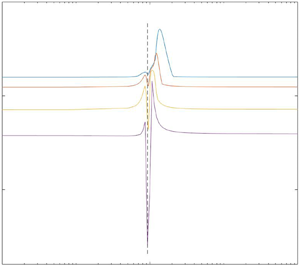Article contents
Density and surface tension effects on vortex stability. Part 2. Moore–Saffman–Tsai–Widnall instability
Published online by Cambridge University Press: 23 February 2021
Abstract

The Moore–Saffman–Tsai–Widnall (MSTW) instability is a parametric instability that arises in strained vortex columns. The strain is assumed to be weak and perpendicular to the vortex axis. In this second part of our investigation of vortex instability including density and surface tension effects, a linear stability analysis for this situation is presented. The instability is caused by resonance between two Kelvin waves with azimuthal wavenumber separated by two. The dispersion relation for Kelvin waves and resonant modes are obtained. Results show that the stationary resonant waves for  $m=\pm 1$ are more unstable when the density ratio
$m=\pm 1$ are more unstable when the density ratio  $\rho_2/\rho_1$, the ratio of vortex to ambient fluid density, approaches zero, whereas the growth rate is maximised near
$\rho_2/\rho_1$, the ratio of vortex to ambient fluid density, approaches zero, whereas the growth rate is maximised near  $\rho _2/\rho _1 =0.215$ for the resonance
$\rho _2/\rho _1 =0.215$ for the resonance  $(m,m+2)=(0,2)$. Surface tension suppresses the instability, but its effect is less significant than that of density. As the azimuthal wavenumber
$(m,m+2)=(0,2)$. Surface tension suppresses the instability, but its effect is less significant than that of density. As the azimuthal wavenumber  $m$ increases, the MSTW instability decays, in contrast to the curvature instability examined in Part 1 (Chang & Llewellyn Smith, J. Fluid Mech. vol. 913, 2021, A14).
$m$ increases, the MSTW instability decays, in contrast to the curvature instability examined in Part 1 (Chang & Llewellyn Smith, J. Fluid Mech. vol. 913, 2021, A14).
JFM classification
- Type
- JFM Papers
- Information
- Copyright
- © The Author(s), 2021. Published by Cambridge University Press
References
REFERENCES
- 3
- Cited by





